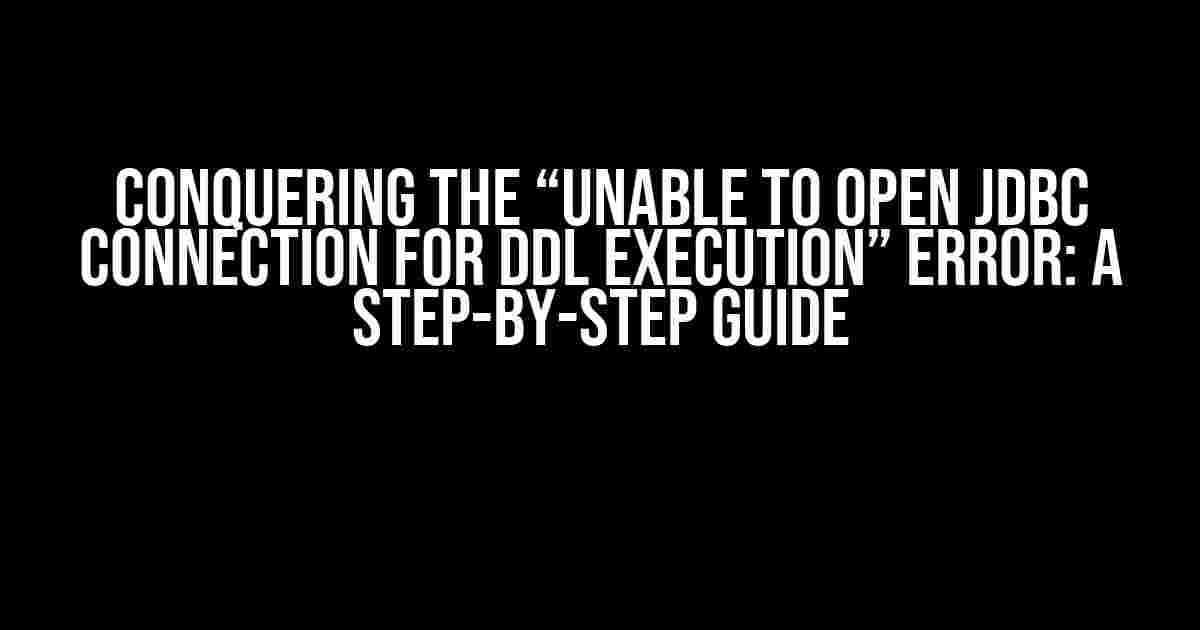Are you struggling with the frustrating “Unable to open JDBC Connection for DDL execution” error? Do the words “encrypt” and “trustServerCertificate” keep popping up in your error message? Worry not, dear developer, for you’ve landed on the right page! In this comprehensive guide, we’ll delve into the world of JDBC connections, SSL encryption, and certificate trusts. By the end of this article, you’ll be armed with the knowledge to tackle this pesky error and get back to coding like a pro!
What’s causing the error?
The “Unable to open JDBC Connection for DDL execution” error typically occurs when your JDBC connection is configured to use SSL encryption, but the necessary certificate trusts are not in place. This error can manifest in various ways, depending on your specific database setup and connection properties. Let’s break down the key components involved:
- JDBC Connection: Your Java application uses a JDBC driver to connect to a database. This connection is established through a URL, username, and password.
- SSL Encryption: To ensure secure data transmission, SSL (Secure Sockets Layer) or TLS (Transport Layer Security) encryption is used. This encrypts the data exchanged between your application and the database.
- Certificate Trusts: When using SSL encryption, your application needs to trust the certificate presented by the database server. This trust is established through a combination of certificate authorities, truststores, and keystores.
Understanding the “encrypt” and “trustServerCertificate” properties
When configuring your JDBC connection, you may encounter the “encrypt” and “trustServerCertificate” properties. These properties play a crucial role in establishing a secure connection:
| Property | Description |
|---|---|
| encrypt | Specifies whether to use SSL encryption for the connection. Set to “true” to enable encryption. |
| trustServerCertificate | Indicates whether to trust the certificate presented by the database server without verification. Set to “true” to trust the certificate. |
Resolving the “Unable to open JDBC Connection for DDL execution” error
Now that we’ve covered the basics, let’s dive into the step-by-step solution to overcome this error. Follow these instructions carefully to resolve the issue:
Step 1: Verify your JDBC connection properties
<?xml version="1.0" encoding="UTF-8"?>
<Configuration>
<Properties>
<Property name="url" value="jdbc:mysql://localhost:3306/mydb"/>
<Property name="username" value="myuser"/>
<Property name="password" value="mypassword"/>
<Property name="encrypt" value="true"/>
<Property name="trustServerCertificate" value="true"/>
</Properties>
</Configuration>
Ensure your JDBC connection properties are correct, especially the “encrypt” and “trustServerCertificate” values. Make sure to update your configuration file or code accordingly.
Step 2: Obtain the database server’s certificate
You’ll need to obtain the database server’s SSL certificate. This can be done in various ways, depending on your database setup:
- MySQL: Use the `mysql` command-line tool to extract the certificate:
mysql -h <host> -u <user> -p<password> -e "SHOW VARIABLES LIKE '%ssl%'" - Microsoft SQL Server: Use the `SQL Server Management Studio` to export the certificate.
- Other databases: Consult your database provider’s documentation for certificate extraction instructions.
Step 3: Create a truststore and import the certificate
Create a truststore using the `keytool` command:
keytool -genkey -alias mytruststore -keyalg RSA -keystore mytruststore.jks
Import the extracted certificate into the truststore:
keytool -importcert -alias mysqlcert -file mysqlcert.crt -keystore mytruststore.jks
Make sure to update your JDBC connection properties to point to the new truststore:
<Property name="javax.net.ssl.trustStore" value="mytruststore.jks"/> <Property name="javax.net.ssl.trustStorePassword" value="mypassword"/>
Step 4: Configure your JDBC connection to use the truststore
Update your JDBC connection code or configuration file to include the truststore properties:
String url = "jdbc:mysql://localhost:3306/mydb";
String username = "myuser";
String password = "mypassword";
String trustStore = "mytruststore.jks";
String trustStorePassword = "mypassword";
Connection conn = DriverManager.getConnection(url, username, password,
new Properties() {{
setProperty("encrypt", "true");
setProperty("trustServerCertificate", "true");
setProperty("javax.net.ssl.trustStore", trustStore);
setProperty("javax.net.ssl.trustStorePassword", trustStorePassword);
}}
);
Step 5: Test your JDBC connection
Attempt to connect to your database using the updated JDBC connection properties. If everything is configured correctly, you should successfully establish a connection:
Statement stmt = conn.createStatement();
ResultSet resultSet = stmt.executeQuery("SELECT * FROM mytable");
while (resultSet.next()) {
System.out.println(resultSet.getString(1));
}
Conclusion
By following this comprehensive guide, you should now be able to resolve the “Unable to open JDBC Connection for DDL execution” error. Remember to carefully configure your JDBC connection properties, obtain the database server’s certificate, create a truststore, and update your connection code to use the truststore. With these steps, you’ll be well on your way to establishing a secure and trusted connection to your database.
Additional Resources
For further reading and troubleshooting, refer to the following resources:
- Java SE 8 Security API Documentation
- MySQL Connector/J Configuration Properties
- Microsoft SQL Server JDBC Driver SSL Encryption
Happy coding, and don’t hesitate to reach out if you encounter any issues!
Frequently Asked Question
Get the answers to the most common questions about “Unable to open JDBC Connection for DDL execution” error.
What causes the “Unable to open JDBC Connection for DDL execution” error when the “encrypt” property is set to “true” and “trustServerCertificate” is set to “true”?
This error occurs when the JDBC connection is unable to establish a secure connection to the database server due to issues with the SSL/TLS certificate. This can happen when the database server’s certificate is not trusted by the client, or when the certificate is expired or invalid.
How can I resolve the “Unable to open JDBC Connection for DDL execution” error when the “encrypt” property is set to “true” and “trustServerCertificate” is set to “true”?
To resolve this error, you can try the following: 1) Verify that the database server’s SSL/TLS certificate is trusted by the client, 2) Ensure that the certificate is valid and not expired, 3) Use a different SSL/TLS certificate that is trusted by the client, or 4) Disable encryption by setting the “encrypt” property to “false” (not recommended).
What are the consequences of disabling encryption by setting the “encrypt” property to “false”?
Disabling encryption by setting the “encrypt” property to “false” can compromise the security of the data transmitted between the client and the database server, making it vulnerable to eavesdropping and tampering. This is not recommended in production environments, as it can put sensitive data at risk.
Can I use a self-signed certificate to resolve the “Unable to open JDBC Connection for DDL execution” error?
While it is possible to use a self-signed certificate, it is not recommended as it can lead to security vulnerabilities. Self-signed certificates are not trusted by default and can cause issues with certificate validation. Instead, consider obtaining a trusted certificate from a reputable certificate authority.
What are some best practices for configuring SSL/TLS certificates for JDBC connections?
Some best practices for configuring SSL/TLS certificates for JDBC connections include: 1) Using trusted certificates from a reputable certificate authority, 2) Ensuring certificate validity and expiration dates, 3) Configuring certificate revocation lists (CRLs) and online certificate status protocol (OCSP), and 4) Implementing secure protocols such as TLS 1.2 or higher.


